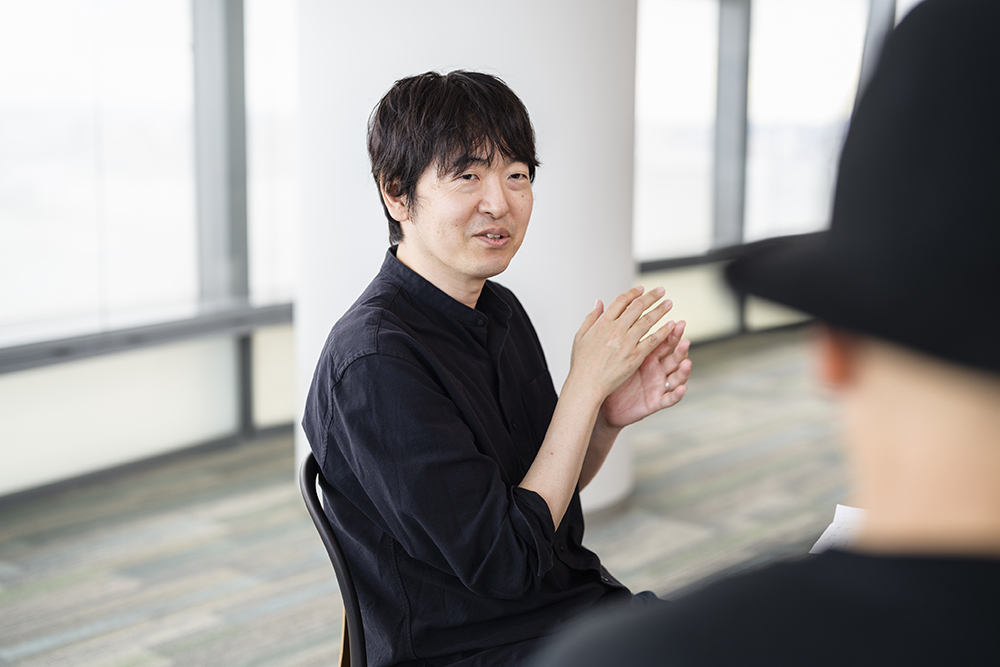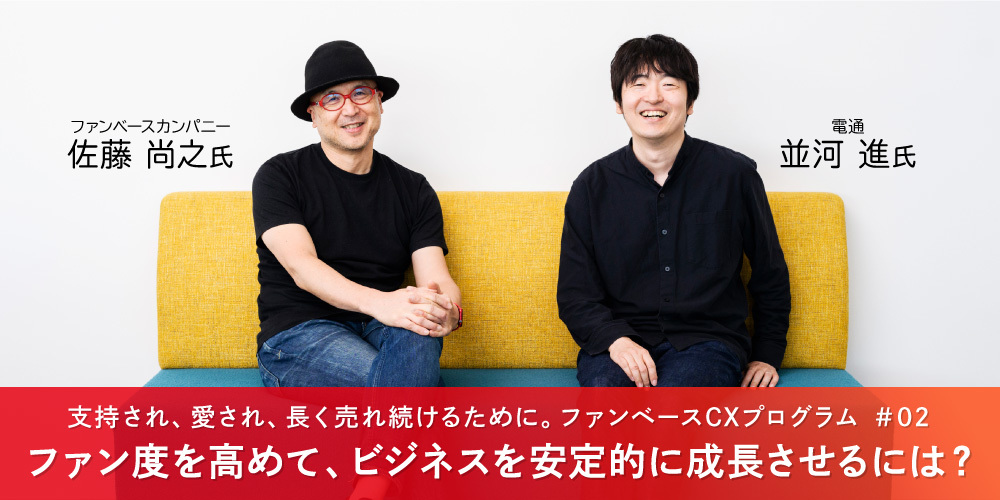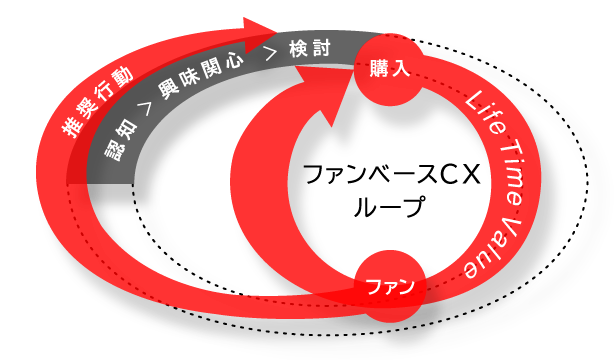Building a business foundation on "fans who love the company" and achieving stable, long-term growth through sustained communication. That is the "Fanbase" concept proposed by Mr. Naoyuki Sato, known as "Satonao."
The approach of pouring budgets into short-term campaigns to generate buzz and acquire large numbers of new customers is becoming less effective. However, by layering various short-term initiatives on top of a fanbase, it's possible to create a loop where existing fans help acquire new fans.
Mr. Sato, Chairman of Fanbase Company, and Mr. Susumu Namikawa of Dentsu CX Creative Center (CXCC) discussed the objectives of the "Fanbase CX Program," jointly offered by the two companies.
"Fanbase CX Program"
This new program reexamines and reconstructs Dentsu Inc.'s "integrated communication across the entire CX" through the "fan-centric perspective" Fanbase Company excels at. It delivers the following four values (see release here ).
① Development and implementation of integrated communication ideas to strengthen current fan relationships and boost recommendation intent
② Creative initiatives linking fan sentiment and recommendation actions to new customer acquisition and expansion
③ "Internal Fanbase" initiatives to boost employee motivation and enhance internal fan engagement
④ Analysis and continuous effectiveness verification using Fanbase Company's proprietary tool, the "Fanbase Diagnosis"
Create a virtuous cycle called the "Fanbase CX Loop"!
Namikawa:Last time we discussed the fundamental concept of the fanbase. This time, I'd like to introduce the "Fanbase CX Program" jointly offered to companies by Fanbase Company and Dentsu Inc.'s CXCC. Before diving into the details, let's first look at the conceptual diagram of the core Fanbase CX Loop to grasp the overall picture.
Namikawa: This diagram combines Fanbase with CX. Unlike traditional funnel or dual-funnel concepts, the key point is that it forms a loop.
Sato: In typical funnel diagrams, it's a straight path from awareness to purchase, but the customer experience (CX) continues beyond that. The loop on the right represents the "LTV" (Lifetime Value) loop driven by existing fans, who keep buying over time. While building on improving this LTV, the other key element of the fanbase—fan "advocacy"—generates new awareness and purchases. That's the loop on the left. These two loops together make the fanbase more robust.
Namikawa: I like to call this swirling vortex created by fans a "gravitational field" (laughs). The Fanbase CX Loop is about drawing people outside this field into it. Brands that attract people aren't just about having good products; they become a brand that includes the fans who love them. The heat generated by these swirling fans is at the core of the brand and product, and the idea is about how to intensify that heat.
Sato: Fanbase CX encompasses everything: continuously improving LTV by raising fan enthusiasm, fan advocacy, and acquiring new customers. In terms of sales, LTV is huge. About 80% of sales come from fans. Fanbase is often seen as a spiritual concept, but it actually directly impacts sales.
Namikawa: The Fanbase CX program fundamentally focuses on how to get closer to this ideal loop. We call it "creating a virtuous cycle of CX." So, how do we actually increase fan engagement? There are actually many touchpoints where we interact with fans. Physical stores, websites, SNS, YouTube channels, sending emails or letters, hosting special events. This program involves starting new initiatives or improving existing ones in these areas. With CXCC members involved, I believe we can leverage ideas and creativity.
※1 LTV: Lifetime Value. The total value a single customer brings to a company over their entire relationship.

Do fans really know what's truly important?
Namikawa:In the previous article, Satonao recommended that companies hold fan meetings to listen to their fans' voices. Recently, I gathered fans and listened to their stories as part of a project with a certain planner manufacturer.
Last time, we discussed "functional value." For example, a planner's function like "managing schedules" can easily be replaced by digital alternatives. But when I spoke with fans of that planner, they said things like, "Seeing my own handwriting brings back the emotions from that time." It's because they hold this kind of "emotional value" for that planner that they buy that company's planner every year.
That made me realize how crucial it is to understand "what feelings fans have when using the product." Because when trying to acquire new customers, even if you appeal to them with "non-traditional uses" and get them to buy, they might ultimately drift away without becoming fans.
Sato: They won't become fans and will leave. And if you run campaigns that miss the emotional value, you risk losing your important existing fans too.
Namikawa: Exactly. So I realized that understanding how existing fans feel and how they use the product is a great model for acquiring new customers too. Existing fans are essentially the "seniors" for new customers.
Sato: That's a crucial point. Generally, the things the seniors love are the things the juniors will love too. If you take a completely different approach for new customers, they'll never reach that level of connection and will leave.
Both companies and ad agencies tend to think, "People who love that planner will use it anyway, so let's just leave them be. We should focus on new customers instead." But leaving them be is absolutely the wrong approach. Fan loyalty will inevitably decline if neglected. By properly increasing existing fans' loyalty, you boost their "LTV" and generate "referrals." To enhance fan loyalty, the aspects fans already cherish are the most crucial.
Namikawa: I see. What really struck me at that planner fan meeting was how skilled the fans are at using the product. They know so much about things like, "This is how you should use it in this situation."
Sato: There's also a network among fans themselves. Even if the company doesn't create a community, fans connect and exchange information among themselves.
Namikawa: Last time we discussed "functional value," "emotional value," and "future value." Companies inevitably focus on enhancing and promoting functional value. But by engaging with fans and understanding the emotional value they cherish, companies gain valuable insights. These insights can then be applied to product improvement and development. Fanbase CX envisions an ideal process where fans and companies mutually discover these insights and grow together.
Sato: That's the best outcome—where fan loyalty increases, LTV rises, and new fans join the loop through recommendations, creating an ever-expanding virtuous cycle.
Namikawa: What I found fascinating about the Fanbase Company approach is how much they value "fans talking among themselves" at fan meetings. Unlike group interviews where questions are posed, when fans talk freely with each other, the conversation really flows.
Sato: When a moderator takes control and asks questions sequentially, the moderator's own biases inevitably creep in, making it harder for the fans' true opinions to surface. Instead, we let the fans freely engage and get excited. That genuine passion born from fans interacting with each other is crucial.
That said, at first, fans often can't articulate exactly what they love. With food or drinks, they might only mention functional values like "It's delicious, right?" Surprisingly, people often forget what they love most. But when they meet other incredibly passionate fans, it accelerates: "Oh, me too!" "That part is the best!" "I had this experience..." It's fascinating (laughs). By energizing conversations among fans, you naturally end up with a treasure trove of golden insights.
Namikawa: Then, based on those insights, you develop an even better CX, further increasing fan loyalty. It's the ideal loop, right? When considering how to approach new customers, using the perspective and mindset of existing fans as the "base" is also a key point of fan-based CX.
Leveraging the skills cultivated by advertising creators for CX!
Namikawa: Much advertising aims to reach people who aren't interested or to get them to notice. But the current thinking is that getting their attention is just the beginning, right?
Sato: That's right.
Namikawa: How do we support customers after they've purchased a product? We view CX across various customer touchpoints as a "line," essentially creating the entire experience in one continuous stroke. We at CXCC are a team of about 100 creators focused on building experiences from a creative perspective—experiences defined by quality, attention to detail, and surprise. It's been two years since we launched, and looking back, we've seen a shift in mindset: the realization that "what happens after we get their attention is just as important."
Sato: I see. It's interesting how advertising creators engaging with CX is driving this shift in mindset.
Namikawa: Personally, I used to prioritize ads that attract new customers above all else. But once I let go of that assumption, I realized that when I personally grow to like a company or product, advertising often isn't the biggest factor. Instead, it's the daily service, the in-store experience, the website, social media—the sum of all those experiences matters more. I now see advertising as just one important part of that broader experience.
Sato: Advertising certainly has its role, but even when investing money, I think we need to shift our perspective slightly from the previous emphasis.
Namikawa: From a creator's perspective, I realized opportunities expand beyond just doing ads. The places where creative power can craft wonderful "experiences" and "expressions" have extended beyond advertising to other customer touchpoints. You can create them in a store, or on a website.
In the CX field, non-creative "mechanisms" used to take precedence. There was CRM (※2) with this technology, or that platform with those capabilities—it was siloed by domain. Over the past two years, we've explored what our creativity can do within those mechanisms. Specifically, ensuring people experiencing them feel happy or at least not stressed. Amidst this, we saw an opportunity not to think in silos by domain, but to view the customer experience as a continuous line and re-examine the entire journey from a fan's perspective. That's why we were asked to join this project.
Sato: Ultimately, the fan base and CX are connected, and I think Dentsu Inc.'s creative strengths can really shine here.
Namikawa: The CXCC creators also gain many discoveries and insights through their interactions with fans.
Sato: That's absolutely true. Even copywriters, for a while, had become somewhat "professionals at making things stand out" or "professionals at grabbing attention," but their true essence is being "professionals at empathy."
Namikawa: I strongly believe a creator's power lies in their ability to notice things. When we talk about creativity, we tend to focus on the "ability to create." But when talking with fans, noticing that "Ah, this is it" moment within their feelings and actions—that's where you can leap to expressions that truly delight fans. It's co-creation, creating together with fans.
Sato: If creators can empathize with fans and then elevate their expression, I think fans will become truly enthusiastic. I believe that's where the power of creators will be needed going forward.
※2 CRM: Customer Relationship Management. Maintaining and fostering positive relationships with customers by providing appropriate responses to each individual.

There's no happier "job of communication" than making fans happy.
Namikawa: I feel the Fanbase CX Program is evolving into truly fulfilling work. Meeting fans who genuinely love a company brings joy to both them and the company—it's an incredibly rewarding experience. Learning from such fans to improve products, businesses, and communication directly fuels corporate growth. For creators, that's an immensely satisfying journey.
Sato: I can't think of anything happier than that (laughs). Broadly speaking, we're in the "communication business." When people who genuinely love the products a company created with blood, sweat, and tears express their appreciation, and we get to delight those people... I can't imagine a happier "communication job" than that.
Namikawa: The fanbase is the foundation of our thinking, the foundation of our customer base, and the foundation of our business. Building CX on top of such a solid foundation feels like it will become a key pillar moving forward.
Sato: Companies originally create products and services to help someone and make someone happy, right? So, I think the fundamental principle of business is to look first at the people who are happiest with what you offer. It's just a matter of returning to that.
Namikawa: Actually, I think truly great TV commercials and outstanding creative work inherently incorporate that perspective.
Sato: Exactly! It's always there. That's why I see fan-based CX less as something new and more as a return to how things should be.
Namikawa: That perspective really resonates with me too. Thank you so much!













